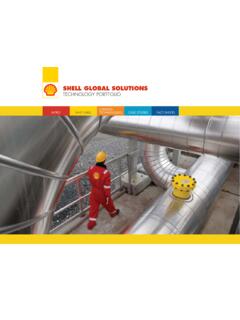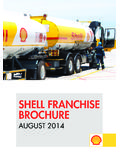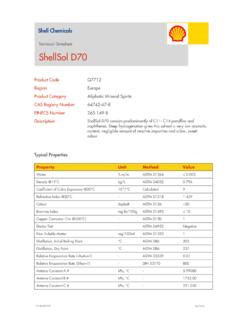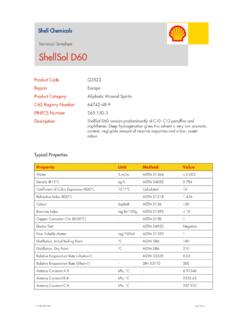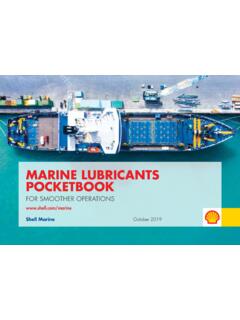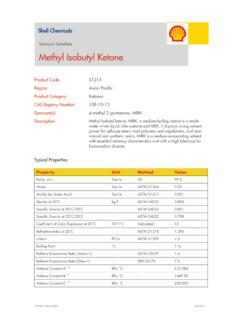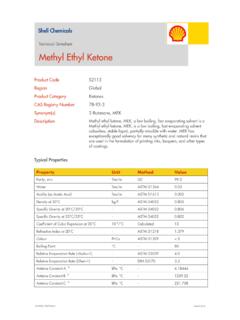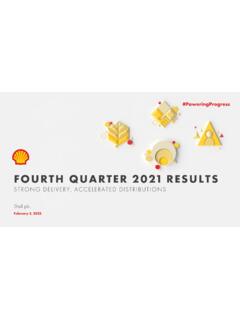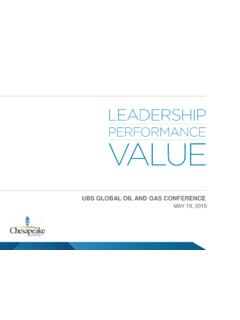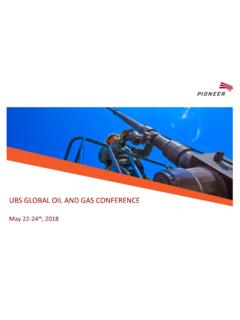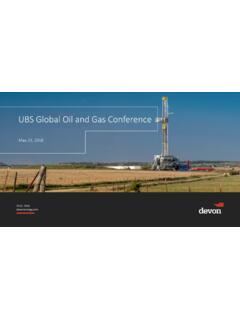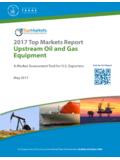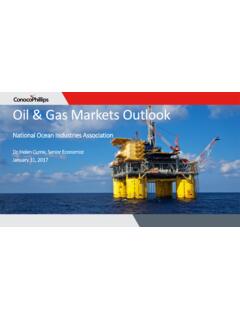Transcription of SHELL GLOBAL SUPPLY MODEL OIL & GAS: A VIEW TO 2100
1 SHELL GLOBAL SUPPLY MODELOIL & GAS: A VIEW TO 2100 ENTER0301 Introduction 0502 What is the GLOBAL SUPPLY MODEL (GSM)? 0703 How does the GSM work? 0904 Main scenario uncertainties 1905 GSM scenario outputs 2106 Who are the people involved? 27 APPENDIX A SUPPLY countries modelled 28 B Environmental module 30 CONTENTSTO NAVIGATECLICK on the RED ARROWS from the contents below or side menu to navigate page by on the MENU ICON in the side menu to come back to the contents from any INTRODUCTIONWim Thomas Chief Energy AdvisorRichard Moore Senior Energy Advisor, Principal Developer of the GSMESTIMATING FUTURE OIL AND GAS PRODUCTION CAPACITY IN A CHANGING ENVIRONMENTThis brochure provides an overview of the long-term GLOBAL SUPPLY modelling methodology we use in SHELL to estimate potential future industry-level oil and gas production in support of our scenarios our scenarios work shows, oil and gas demand will remain significant in the coming decades, even as renewables rise meteorically.
2 This tool allows us to systematically explore future production potential taking into account the best available resource base estimate, present and future technologies, and societal developments in acceptable operating procedures. Development of such a sophisticated tool involves a wide range of experts from numerous areas in the business, all of whom I d like to thank for their years of dedication. We hope you find this brochure helpful in gaining an insight into how we approach forecasting oil and gas production in GLOBAL SUPPLY MODEL (GSM) is a top-down MODEL which allows us to form our own view of long-term oil and gas production collate data from a range of external data providers and combine that with our own internal sources and analyses to build a SHELL view of future production potential. This also allows us to explore key uncertainties and enables us rapidly to quantify different production scenarios for strategic studies and for our wider analysis of the GLOBAL energy system.
3 Increasingly sophisticated versions of the tool have been used for studies in SHELL for a number of years including our 2013 New Lens Scenarios work and we have recently completed the latest version which can now explicitly handle associated gas and natural gas liquids. We continue to work on the GSM, both in terms of its oil and gas SUPPLY forecasting capability and the prediction of key parameters linked to production, such as oil quality, carbon footprint and cost of SUPPLY . 072. WHAT IS THE GSM?What is the GSM? The GSM is a SHELL proprietary GLOBAL oil and gas production MODEL used for quantifying scenarios. The GSM marries techno-commercial and geo-political mechanisms to forecast industry-level future production based on scenario assumptions. The GSM forecast draws on detailed modelling work and analysis such as our North American shale oil MODEL . The GSM is a top-down tool that uses asset-level data aggregated by resource type and geographical location for 90 countries.
4 It forecasts to 2100 for fixed or variable prices. The GSM has the capability to forecast upstream CO2 footprint at the same granular level as oil and gas production. Future versions may also be able to forecast investment costs. The GSM is Visual Basic/Excel-based and can produce a wide variety of customised graphs. Data can be exported for further analysis/post-processing and comparison with other forecasts, as well as being key inputs for SHELL s World Energy MODEL and scenario is its purpose? The GSM provides plausible oil and gas production profiles tailored to SHELL -specific scenarios. The GSM helps to find answers to key questions around uncertainties on oil and gas SUPPLY at a GLOBAL and country level, How much production potential is in which country and from what sources? How much SUPPLY will be available for a prescribed oil price trajectory? Which resource types are produced and what is the upstream environmental footprint? Who are its customers?
5 Within SHELL , the GSM is a key reference MODEL for strategy/planning groups in both the corporate centre and the businesses. Externally, the GSM contributes to SHELL Scenarios AND GAS REMAIN CRITICAL COMPONENTS OF THE ENERGY SYSTEM INTO THE LONG TERM SHELL NEW LENS SCENARIOS100075050025002000 Exajoule/yrUnconventionalLarge volumes that are more difficult to developConventional ReservoirsSmaller volumes that are relatively easy to developThe resource triangle for oil and gasHOLDITCH 2007(NPC)Increasing Complexity/CostsMountainsMountainsOceans Oceans20302060 Oil Gas Coal Biomass/Biofuels Nuclear Other Renewables Solar WindTIGHT OIL SHALE OILTIGHT GAS SANDSOIL SANDSEXTRAHEAVYOILSHALEGASOILSHALECOALBE DMETHANEMETHANEHYDRATESHIGH/MEDIUMQUALIT YOIL & GASS hell AnalysisOIL AND GAS REMAIN CRITICAL COMPONENTS OF THE ENERGY SYSTEM INTO THE LONG TERM SHELL NEW LENS SCENARIOS09 YET-TO-FINDSDISCOVEREDVOLUMESUNDEVELOPED DEVELOPED RESERVESPRODUCTIONThe GSM has three principal components:Resources are matured from exploration to production.
6 RESOURCEMATURATIONPRODUCTIONRESOURCE BASEDEFINITION3. HOW DOES THE GSM WORK?What are the key modelling principles?The GSM combines superimposed Hubbert-like* curves at a level of granularity that maximises the benefits of a top-down empirical approach while retaining sufficient detail to be both relevant and of SUPPLY curves are employed to make forecasts oil price sensitive. Both technical assumptions and policy choices on resource utilisation can be incorporated. Resource and production data is aggregated from external and internal sources much of which are at field level. Tens of thousands of individual assets are compressed into approximately 500 active developed reserve/production buckets , each fed by a resource maturation chain (Undiscovered, Discovered, Undeveloped and Resource Growth due to recovery factor increase). Resources are matured from exploration through discovery to developed reserves using maturation archetypes tuned with country and regional data. Cost of SUPPLY curves control how much resource is economic to mature at a given oil price.
7 Production growth constraints can be applied to the MODEL to reflect geopolitically imposed or other takeaway/upstream constraints. Crude oil and non-associated gas are the primary calculations with associated gas and associated liquids (condensate/natural gas liquids) as secondary calculations. Oil and gas SUPPLY is the core engine with environmental and, in the future, cost estimation being a secondary derivation from production and resource * Hubbert, SHELL Development Company. Nuclear Energy and the Fossil Fuels , American Petroleum Institute Spring Meeting, 1956111. Resource base definitionThe recoverable resource base underpins any production forecast and this can be varied per scenario depending on assumptions of technology progress and policy choices. Data providers have differing views on the expectation (2P Proven & Probable) resource base, even for producing assets. This indicates the level of uncertainty in estimates and allows ranges to be explored.
8 Uncertainty derives from estimates of in-place volumes, the recovery factor, the economics of recovery, the impact of technology advancement over time and the licence to operate from society and governments. Conventional oil and gas has been the main focus of the industry since its inception. As a result, the in-place resource is quite well defined and the major uncertainty lies in the extent of recovery. Globally, the recovery factor for conventional oil fields averages about 35%. The technical limit through improved and enhanced recovery techniques nears 70%, so the assumptions on the extent to which technologies such as water or gas flooding, chemical injection and thermal techniques are applied are critical. Enabled by the oil price increase over the period 2004-2014, unconventionals now represent a significant proportion of the recoverable resource base and recovery estimates may increase further as technology develops and/or the oil price increases. The in-place volumes of unconventional oil are very large but production techniques are complex.
9 Costs can be high and recovery factors are generally low. Initially modest estimates for extra heavy oil and bitumen from Venezuela and Canada have increased due to advances in surface mining and steam-assisted recovery and, now, resource potential is recognised in other countries such as Russia and Kazakhstan. Similarly, early estimates of the potential from shale gas and oil were low but advances in horizontal drilling and multiple fracture stimulation have enabled production in North America to move rapidly down the cost curve. Research & Development work continues on oil production from kerogen ( oil shales ) and gas from methane hydrates. Assumptions on the economics of recovery are key and are incorporated into the REPRESENT THE MAJOR UNCERTAINTY IN THE RESOURCE BASE: UNCERTAINTY IS MANAGED BY USING SCENARIOS100075050025002000 Exajoule/yrUnconventionalLarge volumes that are more difficult to developConventional ReservoirsSmaller volumes that are relatively easy to developThe resource triangle for oil and gasHOLDITCH 2007(NPC)Increasing Complexity/CostsMountainsMountainsOceans Oceans20302060 Oil Gas Coal Biomass/Biofuels Nuclear Other Renewables Solar WindTIGHT OIL SHALE OILTIGHT GAS SANDSOIL SANDSEXTRAHEAVYOILSHALEGASOILSHALECOALBE DMETHANEMETHANEHYDRATESHIGH/MEDIUMQUALIT YOIL & GASBREAKEVEN PRICES AND RESOURCE CHOICES UNDERPIN A SUPPLY SCENARIO THE COST OF SUPPLY CURVE BELOW EXCLUDES KEROGEN AND EXTRA HEAVY OIL OUTSIDE CANADA AND VENEZUELAP roduction mln bbl per dayYearHistoricalForecastOffshore Shelf Offshore Deep Water Offshore ArcticDevelopmentBreakevenCumulativeReso urce Volume(Mmbbl)GSM Liquids Resource Base(undeveloped, SFR and YTF) Tight Oil Conv.
10 Onshore Deepwater Canadian Oil Sands Venezuela EHO Offshore Shelf Arctic SHELL Analysis13 GSM RESOURCE MATURATION ARCHETYPES ARE DERIVED FROM HISTORICAL DATA:COUNTRY SPECIFIC ADJUSTMENTS ARE MADE2. Resource maturationThe real-life maturation process of resources through the exploration phase to discovery, development planning and, ultimately, production is reflected in the GSM. Resource maturation and production algorithms are derived from historical data for each resource type and geographical location. Volumes are discovered over time according to a typical discovery creaming curve. A small proportion of the discovered volumes produce immediately, representing wells that are located close to existing production facilities, but most volumes transition into a planning phase. Discovered volumes are brought into production over time, also using a creaming curve. Reserves growth is introduced over time as recovery factors are assumed to increase with technology progress.

